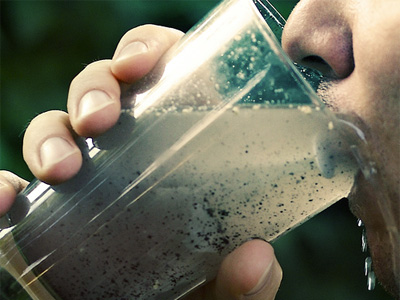
Having water on hand is just one part of being prepared. Knowing how to safely store, treat, filter and purify water can keep you alive. To know how much water to have on hand and how to store it, read Water Storage 101. This article reviews how to make sure water is safe to drink. You can get very, very sick from drinking contaminated water and in a survival situation, sickness can quickly become life or death scenario. You need water, but more importantly, you need safe drinking water.
If you have water stored, you may be certain it is safe to drink, but if you’re using other supplies of water from inside or outside of your home (or you want to make extra sure your water storage is safe), you’ll need to filter and purify it. Should you drink the water? It’s important to know for sure.
Treating stored water
Water bottles and water stored from a safe drinking supply (tap water from a municipal plant) should be fine to drink. Other stored water, such as from a well, needs to have bleach added to it to treat it. The Survival Mom recommends using 1/8 teaspoon of bleach with no additives per gallon if the water is clear.
You should keep some unscented bleach on hand for emergencies, but be aware that bleach does have a fairly short shelf life. It starts to break down after six months and needs to be replaced every 12-16 months. Rotate your bleach bottles frequently to ensure you have effective bleach on hand.
Making water potable requires two steps, filtering and purifying. Filtering removes bits of things, like sand and bugs. It removes big particles, not microscopic ones like bacteria. Purifying removes or kills germs and bacteria, although some methods are more effective than others.
Filtering first and then purifying is the best practice for drinking water, in part because it extends the life of your purifier and in part because some purification methods (such as boiling) do absolutely nothing to filter out debris.
Filtering water
Tap water can become contaminated even in non-emergency situations but more commonly in an emergency. In a non-emergency, you will almost certainly find out either from news stories or when you receive a phone call notifying you to boil your water to make it potable. (Potable water can be safely consumed.)In a true emergency, it is safest to treat your water source as likely contaminated until proven otherwise.
You may have to seek water sources inside your home, like the water heater, or outside the home, like a pond or stream. Water from sources that aren’t guaranteed to be safe should be filtered first and then purified. Filtering removes big impurities like leaves, dirt, insects, and sticks. Towels, screens and coffee filters can be used to filter water. Another way to do it if you don’t have those items on hand is to improvise a water filter that lets the water flow through layers of rocks, sand, and charcoal to filter out debris.
Sometimes commercial “filters” are actually purifiers. It is important to do both steps, so make sure you look closely at what the product actually does because you need both. If it is a purifier, then you need to add a filter – unless you enjoy spider legs and leaves in your drinks.
Purifying water
Once water is filtered, there are several ways to purify it. You can boil it, add bleach, use calcium hypochlorite, use UV light, add water purification tablets, or use a commercial device.
Boiling water can be a great way to purify water, but it does have a couple of downsides. First, it can concentrate any chemical contaminants in the water. As water evaporates as steam, it will leave behind liquid water that may contain a more concentrated level of certain contaminants.
Another downside is that it requires fuel and time for the water to come to a full boil. If either is in short supply, boiling won’t be your best bet.
Otherwise, you want to heat the water to 149 degrees for 1 minute to pasteurize it. Pasteurization actually occurs at a lower temperature than boiling, but you’ll need either a thermometer to verify the water temperature or a WAPI, Water Pasteurization Indicator. This inexpensive device is a handy addition to any emergency kit.
Adding bleach to water can also treat it for some pathogens. The American Red Cross actually recommends boiling and using bleach. If you want to add bleach to water that has been boiled, make sure it has been cooled down first. The water should have a slight chlorine smell once bleach has been added and allowed to sit for at least 30 minutes or so. If you do not smell a bit of chlorine, add another drop or two. (continue reading)

